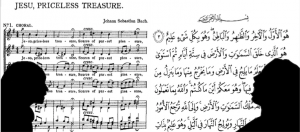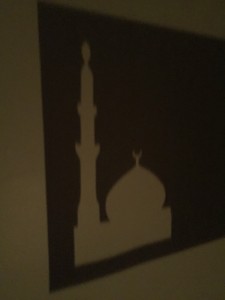Introduction
ø
On the first lecture of the course, For the Love of God and His Prophet: Religion, Literature, and the Arts in Muslim Cultures, Dr. Ali Asani asked the class how we know what we know about Islam. There were a number of answers including the news, popular media, movies, and social media, most of which often portray Muslims negatively. Throughout Dr. Asani’s course I thought about the question and how I have learned about Islam by studying the religion in an academic setting. Taking the time to look into multiple sources ranging from 12th century epic poetry and academic journals to graphic novels and film, it opened my eyes to the world of Islam that I most likely would not have seen had I not sought it out on my own. This essay aims to give the reader a way of thinking about the varieties in which Islam is practiced by introducing the themes present in the subsequent blog posts. These include Islam as a religion (as opposed to political ideology), the diversity of Islam, and the cultural studies approach. Each will be considered and expanded on in relation to the blog posts as well as other sources not otherwise discussed in the blog.
Many Westerners who encounter Islam are often confronted with a radical, dangerous Islam. Because of various conflicts and terrorism, many people learn of the perspective of only a handful of Muslims – an extreme kind of Islam that is more of a political ideology than a spiritual tradition. Many individuals use unsound reasoning to conclude from the violent actions of a few Muslims that all Muslims must be violent or that they must otherwise ascribe to a fundamentalist ideology. In 2010 there were 1.6 billion Muslims in the world[1], roughly 23% of the global population. Given the number of Muslims in the world, non-Muslims (and Muslims too, actually) would do well to try to understand the various meanings that Islam has. Seeing how a religion that has such an influence over the lives of so many people is practiced in different times and places can help us attain a better understanding of humanity, attain insight into global issues, and help us become more enlightened individuals.
The scholar Edward Said wrote, “The problems facing anyone attempting to say anything intelligible, useful, or accurate about Islam are legion. One should therefore begin by speaking of Islams rather than Islam…and then go on the specify which kind, during which particular time, one is speaking about.”[2] As is mentioned in the first blog post, one of the most productive ways of investigating the varieties of Islam (or any religion for that matter) is through a cultural studies approach. Once one understands that there is not one monolithic Islam, as the cultural studies approach recognizes[3], one will be able to attempt and understanding of the varieties of Muslim faith. Asani writes, “A fundamental premise of the cultural-studies approach is that the lack of religious literacy fuels antagonism and prejudice against particular groups.”[4] This ties directly to the claim above regarding hasty generalizations about Islam. A further important premise of the cultural studies approach, Asani writes, “is that the study of religion is an interdisciplinary enterprise that necessitates the use of several perspectives to appreciate the complexities of religious expression.”[5] As I wanted to show a variety the religions and cultural ideas of Islams (as opposed to Islam), my blog posts reflect a variety of perspectives, highlighting religious, spiritual, and artistic practices.
In the first post, ‘Conceptions of Muslims’[6], assumptions of how Muslims are supposed to ‘look’ and what they are supposed to believe is questioned. Shown is a range of individuals varying from a Sufi dancer to an American medical doctor. This post and a number of others can serve as counterexamples to basic assumptions about what Islam is and who Muslims are. Further, the post, ‘Sufi Poetry and Wine’ highlights a perspective that many would see to be blatantly opposed to ‘mainstream’ Islam. The near obsession of poets with wine and intoxication does not fit the preconceived image of Islam. Consider Renard’s description of Ibn al-Farid’s poetry. He writes, “One of [al-Farid’s] most celebrated poems is the ‘Wine Ode’ (‘Al-Khamriya’). It develops the imagery of intoxication as a mystical theme, beginning with an allusion to the lament for the lost loved one. Ibn al-Farid refers to an eternally ancient wine that is divine love.”[7] To quote a line of the poem, “In memory of the Beloved we quaffed a vintage that made us drunk before the creation of the vine.”[8] This imagery seems rather progressive even thought it goes back over eight centuries. The lesson to be learned here is that what is ‘normal’, ‘orthodox’, ‘conservative’, or ‘progressive’ is often times a function of the time in which an idea or practice is presented. What is more, what we take to be progressive now has most likely been advocated for (or even sometimes the norm) in the past.
Another source that shows the diversity of perspectives in Islam is the short story, ‘Sultana’s Dream’, written by Rokeya Sakhawat Hossain in 1905. Hoassain writes of a dream where the roles of men and women are reversed; in particular, men, rather than women, observe purdah. Describing purdah, Hanna Papanek, scholar of Islam, writes, “The forms of purdah observance include spatial separation, the wearing of special garments, several kinds of portable seclusion in which women can move about in public, and certain kinds of body language.”[9] Much like with Islam there are cultural differences in how it is practiced. In any case, in ‘Sultana’s Dream’ Hoassain presents a number of criticisms of the situation of women through satire.
In Ladyland, the city in her dreams, men are “in their proper places” while women have authority, all women are ordered to be educated while men take care of the home, no woman is allowed to be married before the age of twenty-one, and science and reason are valued. Regarding spirituality, the character leading Hossain around Ladyland says, “Our religion is based on Love and Truth. It is our religious duty to love one another and to be absolutely truthful.”[10] The story serves as means of showing that women are just as capable as men in a number of areas. At the time of publication, one critic, Abul Huassain, said that Hossain wrote the story to “create a sense of self-confidence among the very vulnerable Bengali women.”[11] He praises the work and urges men and women alike to learn from it. He writes that “women may possess faculties and talents equivalent to or greater than men—that they are capable of developing themselves to a stage where they may attain complete mastery over nature without any help from men and create a new world of perfect beauty, great wealth and goodness.”[12] Once again, we have an example of a way of thinking that clashes with preconceived notions of what Muslims must think or how they must act. Indeed, the writing of the story of itself is quite outstanding and challenges presuppositions. Roushan Jahan, cofounder of Women for Women, a research group in Bangladesh, writes of Hossain, “Her pen was, first, a weapon in her crusade for social justice, [and] she marshaled her thoughts and arguments in order to question the existing order of things, to raise doubts about seemingly accepted facts, and to motivate people to take the necessary actions to change customs she considered evil and unjust.”[13] While Hossain can be seen as a progressive female Muslim thinker in the 1900’s, individuals today (over a century later) are still fighting for some of the views that she espoused. We ought to appreciate her perspective as part of the foundation of much of the work that is happening today regarding gender equality and for insight into how diverse Islam is, not only today, but historically.
The varieties of Islam can be seen not only in centuries-old poetry, but can be seen in contemporary artwork as well. Consider Marjane Satrapi’s Persepolis, an autobiographical graphic novel about growing up in Iran during the Islamic revolution. Satrapi gives the reader insight into growing up in a Muslim community during that time. Within the first few pages she explains her own context, writing, “I really didn’t know what to think about the veil. Deep down I was very religious but as a family we were very modern and avant-garde. I was born with religion.”[14] Throughout the graphic novel, she is fascinated with aspects of American culture, in particular the music of Iron Maiden and Michael Jackson, as well as jean jackets and Nike shoes. This contrasts with the ideal of many more conservative Muslims during that time. One scene in the book portrays a debate between Satrapi’s conservative schoolteacher and some of the parents. When the teacher suggests that the parents do not know how to educate their own children and that they need to behave, she receives angry responses such as, “Well-behaved? So they can hit themselves twice a day??”[15], “So they can be covered from head to toe?”, and “So that they can be forbidden to play like the kids they are??”[16] Here we see conflicting views of Muslim culture: one very progressive and another more conservative. With these few episodes from Satrapi’s work, we see a variety of perspectives of Muslim life during the Islamic revolution.
I have aimed to show the diversity of perspectives in Islam, as consistent with a cultural studies perspective. In particular I have shown that there are and have been a multitude of ‘unorthodox’ ideas regarding what is acceptable in Islam and who Muslims are. While the works above are aesthetically pleasing in their own right, my focus on them has more to do explicitly with their literal, written content as a means to show different perspectives. Many of the works made by Muslims throughout history can be valued purely for their aesthetic qualities; and it is important to note that the diversity of artwork parallels the diversity of viewpoints. With this essay I have attempted to provide a method of sorts for approaching different Islams. It is my hope that the reader will be able to notice and appreciate the similarities and differences between the various viewpoints addressed in my blog posts. They shed light on various aspects of Islamic art, including sacred architecture, the symbolism of light throughout Islamic spirituality and art, Sufi poetry, and music. However, while I made the distinction between written content and aesthetic qualities, it is important to note that not only works of art can be beautiful; ideas can be beautiful, too. And Islam is full of such ideas that are expressed in beautiful ways. I urge the reader to consider this as they view the following posts.
[1] Michael Lipka, “Muslims and Islam: Key findings in the U.S. and around the world,” Pew Research Center, http://www.pewresearch.org/fact-tank/2015/12/07/muslims-and-islam-key-findings-in-the-u-s-and-around-the-world/ (accessed April 23).
[2] Edward Said, quoted in Ali Asani, Infidel of Love, (forthcoming), 13.
[3] Asani, Infidel of Love (forthcoming), 12.
[4] Asani, (forthcoming) 13.
[5] Ibid., 14.
[6] An interesting point to be made is that, while I criticize mainstream media for its portrayals of Islam, many of the images on my collage are taken from various news sources. The point is that there are positive portrayals of Islam if one seeks them out. This, however is a point I leave the reader to ponder.
[7] John Rendard, Seven Doors to Islam: Spirituality and the Religious Life of Muslims (Berkeley: University of California Press, 1996), 119.
[8] Ibn al-Farid, ‘Wine Ode’ in John Rendard, Seven Doors to Islam: Spirituality and the Religious Life of Muslims (Berkeley: University of California Press, 1996), 119.
[9] Hanna Papanek, ‘Afterword Caging the Lion: A Fable for Our Time’ in Rokeya Sakhawat Hossain, Sultana’s Dream (New York: The Feminist Press, 1988), 63.
[10] Rokeya Sakhawat Hossain, Sultana’s Dream (New York: The Feminist Press, 1988), 16.
[11] Abul Hussain quoted in Roushan Jahan, ‘“Sultana’s Dream”: Purdah Reversed’ in Rokeya Sakhawat Hossain, Sultana’s Dream (New York: The Feminist Press, 1988), 2.
[12] Ibid.
[13] Roushan Jahan, ‘“Sultana’s Dream”: Purdah Reversed’ in Rokeya Sakhawat Hossain, Sultana’s Dream (New York: The Feminist Press, 1988), 3.
[14] Marjane Satrapi, Persepolis, (New York: Pantheon Books, 2003), 6.
[15] This refers to one of the country’s religious rituals. Satrapi writes, “At school, they lined us up twice a day to mourn the war dead. They put on funeral marches, and we had to beat our breasts.” Marjane Satrapi, Persepolis, (New York: Pantheon Books, 2003), 95.
[16] Ibid., 98.








